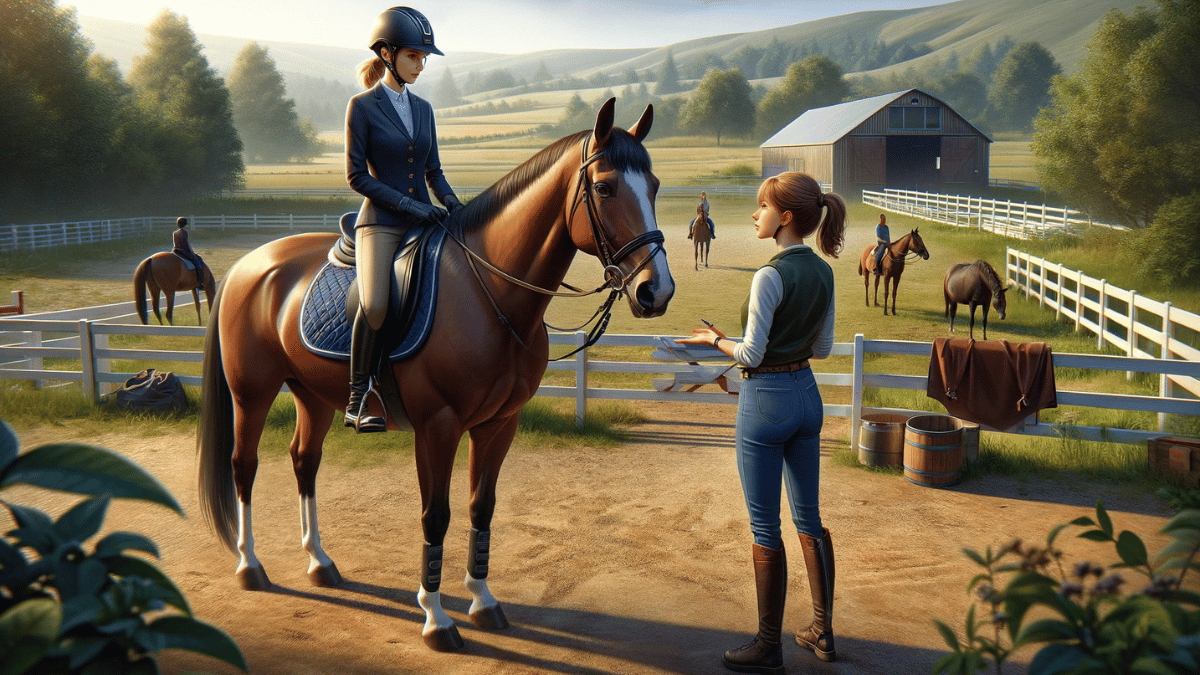Riding horses is a thrilling and rewarding experience, but it’s important to approach it with the right knowledge and guidance.
In this beginner’s guide, we’ll dive into the basics of horseback riding and provide you with useful tips to help you get started on your equestrian journey. From choosing the right instructor and horse to learning proper grooming techniques and mastering riding skills, we’ve got you covered.
Let’s saddle up and explore the wonderful world of horseback riding together!
Choosing a Horseback Riding Instructor

To embark on your horseback riding adventure, it’s crucial to find an instructor who is not only qualified but also a good fit for your learning style. Look for someone you can trust and connect with, as they will be the
key to preventing bad habits and ensuring your safety.
The right instructor will guide you through the ups and downs of your riding experience and make it enjoyable. So take your time to research and find an instructor who resonates with you.
Choosing the Right Horse
When starting out, it’s essential to ride a calm and forgiving horse. A gentle horse with a relaxed and tolerant nature is perfect for beginners.
As you learn, you’ll inevitably make mistakes. Having a patient and understanding equine partner will boost your confidence.
Focus on riding horses that are calm and can handle novice riders’ errors. Remember, building a strong foundation starts with the right horse.
Brushing
Before every ride, it’s important to establish a connection with your horse through grooming. Brushing your horse not only helps prevent saddle sores but also serves as a bonding experience.
Take your time to care for your horse, appreciating their beauty and preparing them for the ride ahead. By spending this quality time together, you’ll create a positive and trusting relationship.
Saddling
Proper saddling is crucial for your horse’s comfort and your safety.
- Start by placing a saddle pad on your horse’s back, ensuring it’s positioned correctly.
- Then, carefully secure the saddle, making sure it sits behind the shoulder blade and locks into place.
- Lastly, secure the girth to keep the saddle in position.
By saddling your horse correctly, you ensure a comfortable and secure riding
experience.
Bridling
Now comes the exciting part – bridling your horse. Begin by carefully placing the reins over the horse’s head for control if needed. Then, remove the halter and take your time to put on the bridle correctly.
Remember to always have a properly adjusted throat latch to prevent the bridle from slipping off. This ensures the horse’s safety and keeps you in control.
Riding Attire
Before hopping in the saddle, make sure you’re dressed appropriately.
- Start with a well-fitted helmet to protect yourself in case of a fall.
- Wear long pants to prevent chafing.
- Use close-toed boots with a stable heel that won’t slip through the stirrups
Dressing safely ensures a comfortable and secure riding experience.
Mounting
When it’s time to mount your horse, use a mounting block to minimize strain on your horse’s back. Line your horse up with the block, switch hands, and lead them forward. Place your hand in the middle of the saddle, push off with your right hand, and swing over. Lastly, wiggle your ankle and catch the stirrup, ensuring a secure and confident mount.
Holding the Reins
Now that you’re in the saddle, it’s essential to hold the reins correctly. Slide your hands down, separating the reins, and hold them lightly between your thumb and pointer finger. Keep your thumbs up, as if holding an ice cream cone. This grip allows for clear communication with your horse and maintains a soft connection.
Correct Riding Position
Maintaining a correct riding position is crucial for balance and harmony with your horse. The ideal position is ear, shoulder, hip alignment, which ensures stability and helps you work with the horse’s motion.
Remember, if the horse were to disappear, you should land on your feet in a kneeled position.
Practice good posture and alignment for a safe and enjoyable ride.
Going Forward & Stopping
To start moving forward, look where you want to go, sit tall, and squeeze with your seat, then thigh, and calf. Relax your leg as your horse starts walking, following the motion with your seat.
When you want to stop, relax and engage your core, sitting back slightly. If necessary, squeeze the reins gently.
These techniques will help you establish control and communicate with your horse effectively.
Steering
Mastering the art of steering is essential for navigating your horse in the desired direction. Use your core, legs, and reins to guide your horse. Visualize closing the door you don’t want your horse to go through and opening the door you want them to pass through. Apply pressure with your leg on the side you want to turn and open the corresponding rein. Practice these cues, and soon you’ll be gracefully handling turns like a seasoned equestrian.
The Horsemanship Journey
Embracing horseback riding and improving your horsemanship is an incredible journey filled with ups and downs. If you’re on this journey, watch the video below.
You can also find more great horseback riding videos on the JSHorsemanship YouTube channel.
Conclusion
Are you ready to embark on your equestrian adventure? What aspect of horseback riding are you the most excited to explore? Share your thoughts with us in the comments below.
If you’re craving more leisure, be sure to check out our comprehensive Hobbies and Leisure Guide for endless inspiration.

